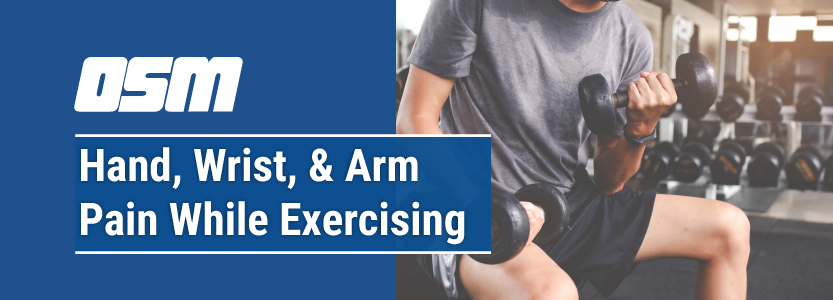Hand, Wrist, And Arm Pain While Exercising
Article featured on American Society for Surgery of the Hand
Is it normal to have pain or soreness in my hands, wrists, and arms while exercising?
It depends. When you start with exercises you have never done or when you exercise some muscles you have not used in a while, these muscles can become sore. That is normal. Muscle activity produces lactic acid, which causes soreness in the muscles. Soreness means your muscles have been stressed, and they will likely recover after a few hours or a few days, when the lactic has been cleared away. If the exercise causes too much stress, your muscles may become sore to the touch and even might feel swollen.
Is there a difference between discomfort and pain in the hands, wrists, and arms?
“Discomfort” is an annoying sensation of mild pain; actual “pain” is when you feel that there is something wrong. In your physician’s office or in the hospital, you are often asked to rate your pain as a number or point to a picture of a face indicating your discomfort. The level of discomfort or pain is very different in each patient. It depends much on how you have been able to deal with uncomfortable situations in the past.
When should I pay special attention to my muscle or joint pain in my hands, wrists, and arms while exercising?
Most exercise-related pain is dull and spreads over a larger area of your arms or legs. This is normal. When it seems to be sharp pain focused in one spot that you can pinpoint with a finger, it may indicate a muscle strain of a tendon inflammation. Popping, clicking, or grinding in the muscles or tendons are signs of strain. You should cut back on the exercise or activity until the problem settles down. Also, you should watch for painful swelling, especially when compared to the other arm or leg. If rest or over-the-counter medications do not help, you should seek your doctor’s advice.
How can I prevent pain in my hands, wrists, and arms while exercising?
Athletic exercises or exercises in your occupation/physical therapy department are meant to make your muscles and tendons more tolerant to stress and strain, so some soreness is normal. The best way to ease into exercises is to work your muscles gradually to the point of discomfort but not pain. Your occupational therapist can assist you to become more flexible and stronger.
How do I treat pain in my hands, wrists, and arms after exercise?
It is helpful to know that discomfort is often the result of exercise. It does not mean that there is anything wrong with your muscles or your body. Staying active and exercising regularly is healthy and will make it easier for your muscles to recover. It is best to “listen to your body” and back off if exercises are too uncomfortable. Over-the-counter medications, such as a cream applied to the sore area or an occasional anti-inflammatory tablet, can be used.
The Orthopedic & Sports Medicine Center of Oregon is an award-winning, board-certified orthopedic group located in downtown Portland Oregon. We utilize both surgical and nonsurgical means to treat musculoskeletal trauma, spine diseases, sports injuries, degenerative diseases, infections, tumors and congenital disorders.
Our mission is to return our patients back to pain-free mobility and full strength as quickly and painlessly as possible using both surgical and non-surgical orthopedic procedures.
Our expert physicians provide leading-edge, comprehensive care in the diagnosis and treatment of orthopedic conditions, including total joint replacement and sports medicine. We apply the latest state-of-the-art techniques in order to return our patients to their active lifestyle.
If you’re looking for compassionate, expert orthopedic surgeons in Portland Oregon, contact OSM today.
Phone:
503-224-8399
Address
1515 NW 18th Ave, 3rd Floor
Portland, OR 97209
Hours
Monday–Friday
8:00am – 4:30pm




